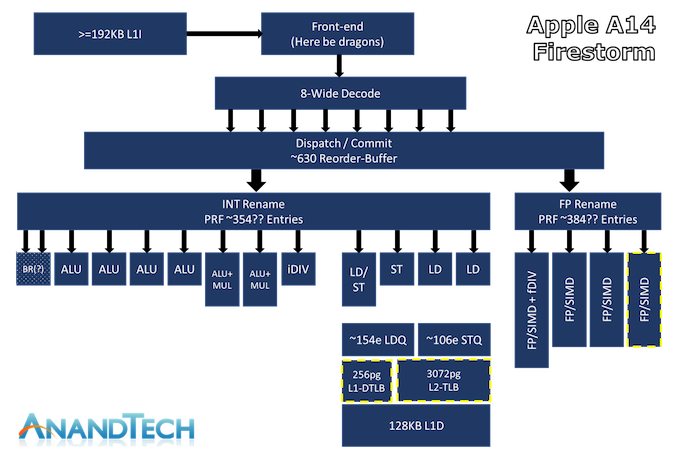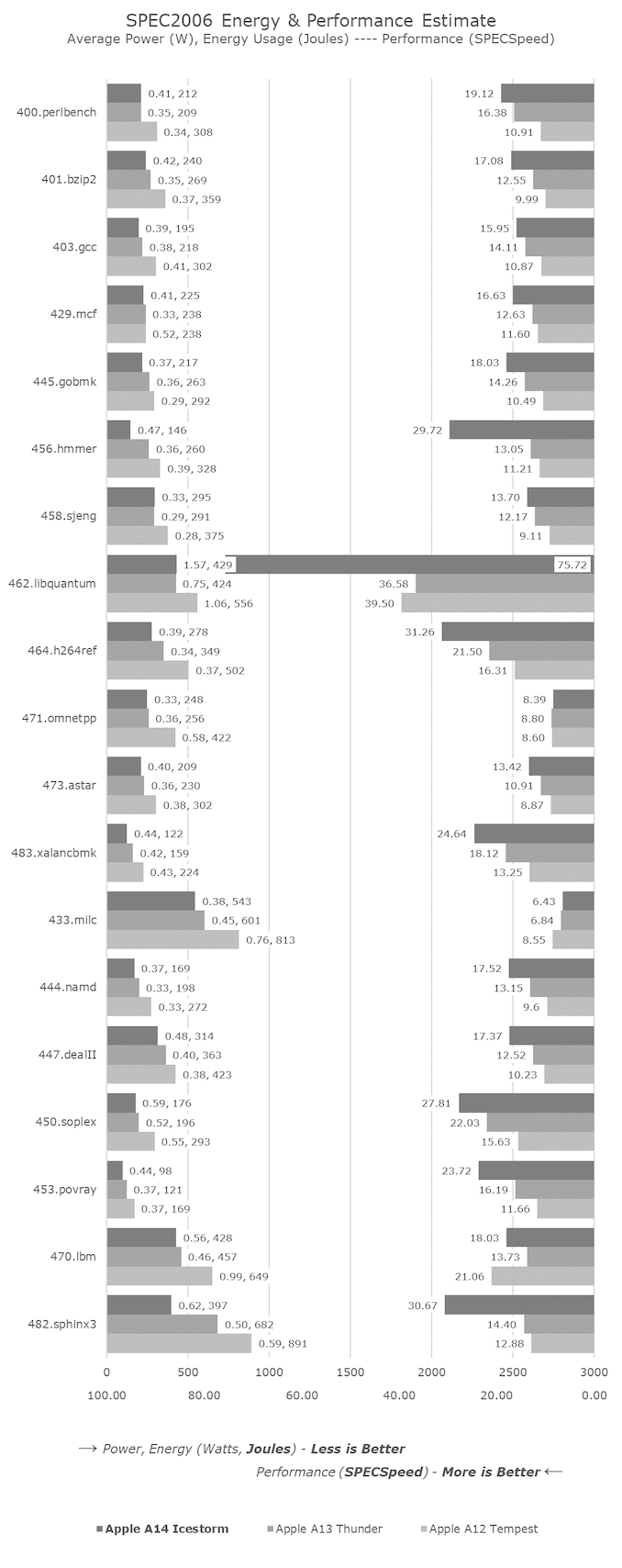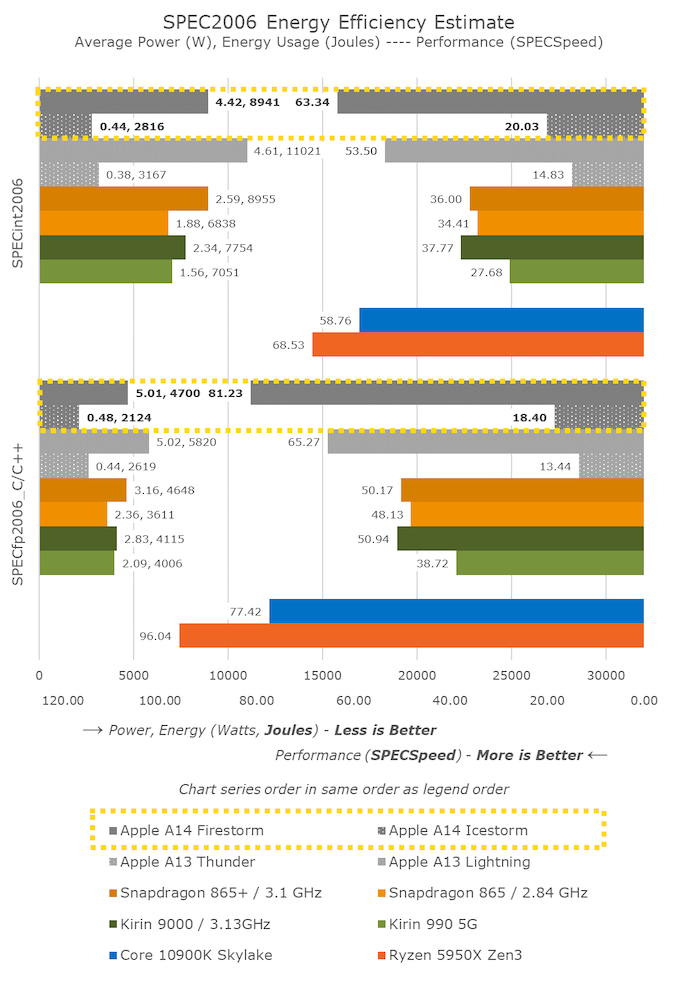The iPhone 12 & 12 Pro Review: New Design and Diminishing Returns
by Andrei Frumusanu on November 30, 2020 8:30 AM EST- Posted in
- Mobile
- Apple
- Smartphones
- Apple A14
- iPhone 12
- iPhone 12 Pro
The Apple A14 SoC: Firestorm & Icestorm
The new Apple A14 is the company’s newest mobile SoC and sits at the heart of the new iPhone 12 series. The new chip is the industry’s first commercial 5nm manufactured chip from TSMC, alongside the now no longer manufactured Kirin 9000.
Inside the A14 we find two big performance cores dubbed “Firestorm” and four efficiency cores called “Icestorm”, making this a 2+4 heterogeneous CPU SoC. Alongside the CPUs, we also find a 4-core GPU. Unfortunately this year it seems like we haven’t seen a public die shot of the A14, though Apple themselves published a shot of the M1 during their announcement event.
| Maximum Frequency vs Loaded Threads Per-Core Maximum MHz |
||||||
| Apple A13 | 1 | 2 | 3 | 4 | 5 | 6 |
| Performance 1 | 2666 | 2590 | 2590 | 2590 | 2590 | 2590 |
| Performance 2 | 2590 | 2590 | 2590 | 2590 | 2590 | |
| Efficiency 1 | 1728 | 1728 | 1728 | 1728 | ||
| Efficiency 2 | 1728 | 1728 | 1728 | |||
| Efficiency 3 | 1728 | 1728 | ||||
| Efficiency 4 | 1728 | |||||
| Apple A14 | 1 | 2 | 3 | 4 | 5 | 6 |
| Performance 1 | 2998 | 2890 | 2890 | 2890 | 2890 | 2890 |
| Performance 2 | 2890 | 2890 | 2890 | 2890 | 2890 | |
| Efficiency 1 | 1823 | 1823 | 1823 | 1823 | ||
| Efficiency 2 | 1823 | 1823 | 1823 | |||
| Efficiency 3 | 1823 | 1823 | ||||
| Efficiency 4 | 1823 | |||||
The new A14 raises the clock speeds of the CPU by a good amount, now essentially reaching 3GHz on the large performance cores in single-threaded scenarios. Once a second big cores come on this reduces to 2.89GHz and stays there even in heavier multi-threaded workloads. The efficiency cores land in at 1823MHz now, roughly a 100MHz boost over the A13, but we do know that in power unconstrained scenarios they can reach quite higher, such as 2064MHz employed on the M1.
The summary is that in this generation, Apple progresses the design further and making it wider than before, increasing the ROB size from 560 to 630, having significantly larger L1 DTLB which has now doubled in size from 128 pages to 256 pages, and increasing the L2 TLB from 2048 pages to 3072 pages. It’s particularly on the part of the floating point and vector execution units where the new Firestorm cores saw most of the design changes this year through the introduction of a 4th pipeline unit, essentially increasing the execution capabilities of this part of the design by 33%. On the integer side of the CPU, things have remained relatively the same with only minor changes, and the Firestorm cores continue on with the sale 192KB L1 I-cache and 128 L1 D-cache and 8MB of shared L2 amongst the two cores.
What we didn’t cover in more detail in the M1 piece was the new small efficiency cores. The Icestorm design is actually a quite major leap for Apple as it sees the introduction of a third integer ALU pipeline, and a full second FP/SIMD pipeline, vastly increasing the execution capabilities of this core. At this point it would be wrong to call it a “small” core anymore as it now essentially matches the big core designs from Arm from a few years ago, being similar in complexity as an A75.
Looking at the generational improvements of the efficiency cores we can see that Apple is indeed showcasing performance increases beyond that of just the increased 100MHz of the cores, with substantial upgrades across the workload spectrum.
Especially the floating-point workloads of the SPEC suite see very large improvements, exactly in the tests which are more execution heavy such as 453.povray or 482.sphinx3.
Apple still continues to limit the absolute performance of the efficiency cores when they are the only allowing the memory controller to not scale up to a higher frequency, meaning that the scores here in isolation are posting worse performance than in a normal more varied real-world scenario where the big CPU cores or the GPU would also be active, hence the scores aren’t directly comparable to other measurements we’ve made.
Overall, the new A14 is massively impressive and grows the performance gap compared to the competition. Apple has now reached higher single-threaded performance within their phone SoCs than what Intel can deliver in any of their designs, whilst only losing out to the desktop variants of AMD’s new Zen3 processors.
What’s important to note here is that Apple’s performance increase this generation did not come at a cost of increased power consumption, as the designers were able to leverage the microarchitectural improvements and the new process node – actually reaching either power parity or a small power reduction compared to the 7nm based A13. This means that the performance increases this generation also results in an energy efficiency increase for the design, with the A14 using notably less energy to complete a workload.
I’ve included the efficiency cores in the chart here to showcase that they’re not weak at all. The performance showcased here roughly matches a 2.2GHz Cortex-A76 which is essentially 4x faster than the performance of any other mobile SoC today which relies on Cortex-A55 cores, all while using roughly the same amount of system power and having 3x the power efficiency.













101 Comments
View All Comments
GC2:CS - Monday, November 30, 2020 - link
Displaymate says peak white is like 10% down compared to 11 Pro.11 Pro was 8% down from the XS but at higher max brightness the efficiency suffers (apple said 15% better isoperf).
That combined with the A14 would pretty much eliminate any fears of downgraded battery life. Unless you turn 5G on.
KPOM - Monday, November 30, 2020 - link
Still better than what iPhones can draw from normal Qi chargers.calleng - Monday, November 30, 2020 - link
All this talk about edges and surface of the phone is bull. Who uses an iphone without a proper case. Maybe apple should make them out of rubber.Andrei Frumusanu - Monday, November 30, 2020 - link
If we didn't care about the design then why bother with a heavier steel variant then? I don't care for cases for one and use all my phones naked.zanon - Monday, November 30, 2020 - link
calleng is completely off base but I do sympathize with Apple being tugged multiple ways here. If 70-80% of owners use a case, well, 20-30% naked is still a LOT. Tens of millions, and reviewers in particular always mention it, and it's what people feel in the store too. So it definitely matters to pay major attention to a quality naked phone experience. Yet that doesn't change a super majority using it with a case, and Apple can't possibly be completely ignoring that either."Why bother with a heavier steel variant then" though really is an interesting question give the noticeable weight difference. There are lots of other premium materials, titanium of course but also all sorts of alloys and even ceramics that Apple has worked with in the past. Steel is certainly really versatile and can be very tough, but it's still a curious choice for a company that has tended to pay a lot of attention to weight and hand feel. As you say in the review it's genuinely debatable if it even is more "premium" here, and it's not like Apple doesn't have serious materials chops. They have high end titanium case options for their watches as well.
cha0z_ - Tuesday, December 1, 2020 - link
The last pools I saw on the subject (this summer), it was 50% using their phones naked and 50% with a case. ;) the pool had around 40 000 voters.cha0z_ - Tuesday, December 1, 2020 - link
Same, used all of my phones totally naked (no case, no screen protector) - all in perfect condition.FunBunny2 - Tuesday, December 1, 2020 - link
from what I gather, most cracked screens are from butt compression due to carrying in back pocket. spongy rubber-ish case won't stop that.iphonebestgamephone - Tuesday, December 1, 2020 - link
Look harder and youll see how its not perfect.Unashamed_unoriginal_username_x86 - Tuesday, December 1, 2020 - link
I know it's not as comfortable or sexy, but I hope you put something on when you go outside. I don't want you getting arrested!